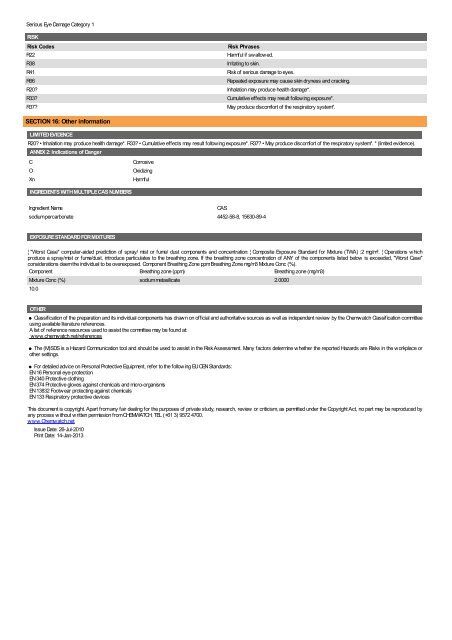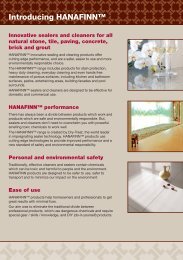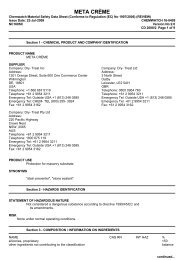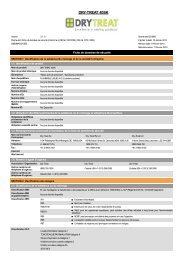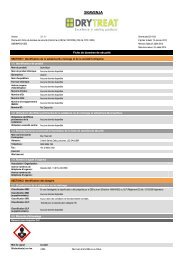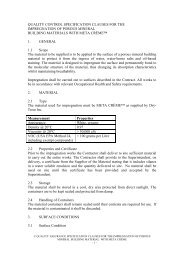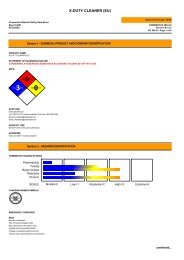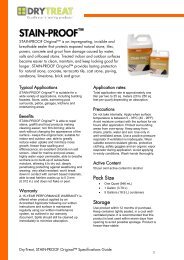Oxy-Klenza MSDS (UK) - Dry Treat
Oxy-Klenza MSDS (UK) - Dry Treat
Oxy-Klenza MSDS (UK) - Dry Treat
You also want an ePaper? Increase the reach of your titles
YUMPU automatically turns print PDFs into web optimized ePapers that Google loves.
Serious Eye Damage Category 1<br />
RISK<br />
Risk Codes Risk Phrases<br />
R22 Harmful if swallowed.<br />
R38 Irritating to skin.<br />
R41 Risk of serious damage to eyes.<br />
R66 Repeated exposure may cause skin dryness and cracking.<br />
R20? Inhalation may produce health damage*.<br />
R33? Cumulative effects may result following exposure*.<br />
R37? May produce discomfort of the respiratory system*.<br />
SECTION 16: Other information<br />
LIMITED EVIDENCE<br />
R20? • Inhalation may produce health damage*. R33? • Cumulative effects may result following exposure*. R37? • May produce discomfort of the respiratory system*. * (limited evidence).<br />
ANNEX 2: Indications of Danger<br />
C Corrosive<br />
O Oxidizing<br />
Xn Harmful<br />
INGREDIENTS WITH MULTIPLE CAS NUMBERS<br />
Ingredient Name CAS<br />
sodium percarbonate 4452-58-8, 15630-89-4<br />
EXPOSURE STANDARD FOR MIXTURES<br />
¦ "Worst Case" computer-aided prediction of spray/ mist or fume/ dust components and concentration: ¦ Composite Exposure Standard for Mixture (TWA) :2 mg/m³. ¦ Operations which<br />
produce a spray/mist or fume/dust, introduce particulates to the breathing zone. If the breathing zone concentration of ANY of the components listed below is exceeded, "Worst Case"<br />
considerations deem the individual to be overexposed. Component Breathing Zone ppm Breathing Zone mg/m3 Mixture Conc (%).<br />
Component Breathing zone (ppm) Breathing zone (mg/m3)<br />
Mixture Conc (%) sodium metasilicate 2.0000<br />
10.0<br />
OTHER<br />
Classification of the preparation and its individual components has drawn on official and authoritative sources as well as independent review by the Chemwatch Classification committee<br />
using available literature references.<br />
A list of reference resources used to assist the committee may be found at:<br />
www.chemwatch.net/references<br />
The (M)SDS is a Hazard Communication tool and should be used to assist in the Risk Assessment. Many factors determine whether the reported Hazards are Risks in the workplace or<br />
other settings.<br />
For detailed advice on Personal Protective Equipment, refer to the following EU CEN Standards:<br />
EN 16 Personal eye-protection<br />
EN 340 Protective clothing<br />
EN 374 Protective gloves against chemicals and micro-organisms<br />
EN 13832 Footwear protecting against chemicals<br />
EN 133 Respiratory protective devices<br />
This document is copyright. Apart from any fair dealing for the purposes of private study, research, review or criticism, as permitted under the Copyright Act, no part may be reproduced by<br />
any process without written permission from CHEMWATCH. TEL (+61 3) 9572 4700.<br />
www.Chemwatch.net<br />
Issue Date: 26-Jul-2010<br />
Print Date: 14-Jan-2013


